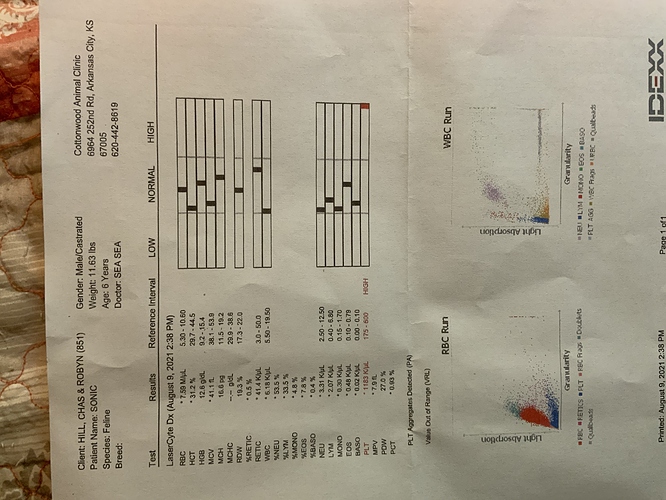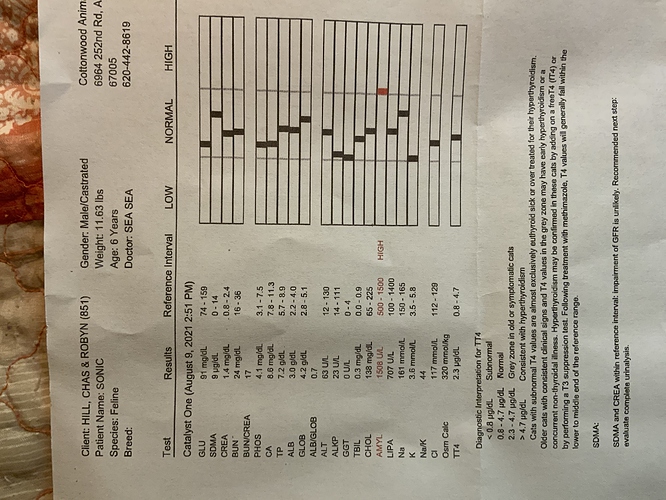Well, that’s when I found him 6 years ago, when he was a kitten. 
Did you ever get the labs? And do you mean Cerenia and not Convenia? What was the reasoning behind Convenia if not? How is kitty now?
Ahhh, gotcha.
Have you considered that he may have gotten injured, bled profusely, and healed pretty well by the time he came back? That could explain the anemia and otherwise normal labs, perhaps even the behavioral change, if he’s still in pain.
Did you do any radiographs? It’s a huge shot in the dark, but perhaps there’s a foreign object that caused a bleeding wound, that’s healed over, and causing pain. Maybe just shooting an AP and lateral of the whole cat could give you a look.
We didn’t do rads, but there were no wounds visible, healed or otherwise.
Here’s the most recent of his labs, from August 9.
The results of the CBC (complete blood count) do not look like anemia to me. The results are all within the reference range, and only the WBC (white blood cell) count is borderline low, but this doesn’t have anything to do with the red cell results.
On a CBC panel, 5 tests evaluate the red cells. These are:
RBC (red blood cells)–This is simply a measure of how many red cells are in a microliter of blood. Your cat’s RBC is 7.59, which is well within the reference range of 5.30-10.60. This means your cat has plenty of red blood cells.
HGB (hemoglobin)–This is a measure of how much hemoglobin is in a deciliter of blood. Again, your cat’s hemoglobin is well within the reference range and he has a healthy amount of hemoglobin.
HCT (hematocrit)–This describes the percentage of the whole blood volume that consists of red blood cells. Blood consists of liquid (plasma) and solids (red cells, white cells, and platelets). If you spin a blood sample in a centrifuge, it will separate into a column of red cells topped by white cells and platelets, with the plasma on top. The hematocrit is the portion (percent) of the column that is comprised of red cells. Your cat’s hematocrit is within the normal range at 31.2%. More significant, though, is that the hematocrit does not match the hemoglobin, but I’ll come back to that in a minute.
MCV (mean cell volume)–This is a measurement of the average size of the red blood cells. Your cat’s MCV is 41.1, which is within the reference range of 38.1-53.9. This means his red cells are a normal size.
MCH (mean hemoglobin concentration)–This describes the average amount of hemoglobin in a red cell. You can see that your cat’s MCH is at about the middle of the reference range, and this means he has a normal and healthy amount of hemoglobin in his red cells.
RDW (red cell distribution width)–This describes how much the red cells vary in size. The red blood cells should be pretty much the same size. If the sizes vary (lots of big cells and lots of little cells) this can help diagnose an anemia. Your cat’s RDW is normal.
The only result on this CBC that concerns me is the hematocrit. In humans, the hematocrit and the hemoglobin should match. I don’t know if this is true for cats, but let’s assume it is. This means that the hematocrit should be within the range of 3 times the hemoglobin plus or minus 3. In other words, for your cat, if the hemoglobin is 12.6, then the hematocrit should fall within the range of 34.8 - 40.8. At 31.2%, your cat’s hematocrit does not fall within this range.
In human medicine, when the hemoglobin and hematocrit don’t match, that’s a red flag to find out the reason why. One possible reason is that the sample was hemolyzed or possibly not mixed adequately, and this is what I would consider first. If you’re worried about it, start by re-checking the CBC. Another possibility is some autoimmune problem like cold agglutinins, but I don’t know how likely that is in cats.
A bit of a long winded explanation, but I hope it helps.
Agree with above. There no anemia or acute renal failure.
I noticed one other result on Sonic’s CBC that is out of range–the platelets are almost twice the upper limit of the reference range. I don’t know anything at all about thrombocytosis (the technical term for elevated platelets) in cats, but the two quotes below are from a publication of Cornell University:
“Usually, a platelet count higher than the reference interval for the species is a reactive thrombocytosis and not of direct pathologic importance.”
“In cats, infectious or inflammatory disorders were the most common underlying diseases and the gastrointestinal system the most frequently involved organ (Rizzo et al 2007).”
Here’s a link to the article: https://eclinpath.com/hemostasis/disorders/platelet-numbers/ Scroll way down the page to the section on thrombocytosis.
In Sonic’s case, the elevated platelets may be a transient reaction to whatever happened to him while he was missing. Maybe he had or still has a viral or bacterial GI infection. Have you seen any sign of diarrhea?
I noticed the labs were run at Idexx. Would it be possible for your vet to consult with one of their pathologists? A pathologist could help interpret the lab results and offer suggestions about what to do next, if anything.
How is Sonic doing now?
I noted that last night and googled high PLT also and didn’t find anything as useful as you did, so didn’t post then.
But I did find one discussion with someone asking about high platelets in two subsequent tests on their cat, one during and one shortly after a bout with (I believe it was) a GI virus, and someone responding to that post said it could due to that (which is supported by Cornell’s publication), but also that it could take a good month for numbers to return to normal.
So it sounds like it’s not a reason to panic at this point (easy for me to say!), that watchful waiting is what’s called for, with an optional recheck of blood values after several more weeks if he continues to do better & nothing concerning becomes evident before then.
Thanks, everyone, for looking at these.
This was the second round of blood work we did (the first was a week earlier), but numbers had not significantly changed in that amount of time. I want to take him back next week for another draw, to see if anything looks different.
@OzarksRider - to answer your questions, he’s eating well; no diarrhea, no vomiting, nothing that would indicate a GI problem. But it might be that he had it during that time, and is still recovering. He’s been a bit quieter than usual, but it’s also been very hot here lately.


